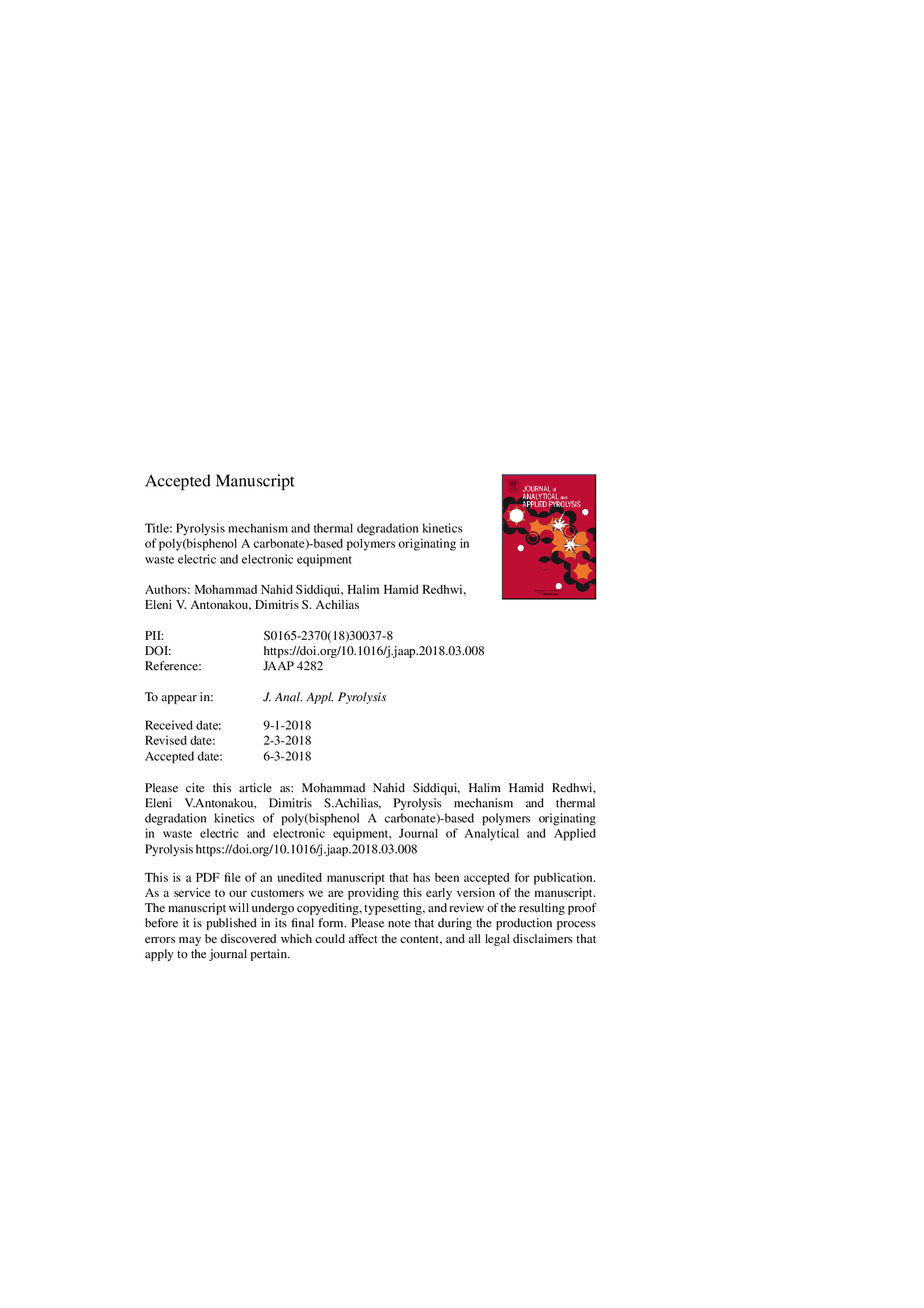| کد مقاله | کد نشریه | سال انتشار | مقاله انگلیسی | نسخه تمام متن |
|---|---|---|---|---|
| 7606301 | 1492945 | 2018 | 40 صفحه PDF | دانلود رایگان |
عنوان انگلیسی مقاله ISI
Pyrolysis mechanism and thermal degradation kinetics of poly(bisphenol A carbonate)-based polymers originating in waste electric and electronic equipment
ترجمه فارسی عنوان
مکانیزم پیرولیز و سینتیک تشدید حرارتی پلیمرهای مبتنی بر پلی (بسفنول آ کربنات) که از مواد زائد الکتریکی و الکترونیکی
دانلود مقاله + سفارش ترجمه
دانلود مقاله ISI انگلیسی
رایگان برای ایرانیان
کلمات کلیدی
موضوعات مرتبط
مهندسی و علوم پایه
شیمی
شیمی آنالیزی یا شیمی تجزیه
چکیده انگلیسی
Poly(bisphenol A carbonate) or polycarbonate (PC) constitutes a significant fraction of the Waste Electrical and Electronic Equipment, mainly due to its high production and consumption rate and its variety of applications. Traditional methods for its treatment no longer appear to provide long-term solutions and for this reason, the investigation of thermochemical methods and more specifically pyrolysis as a potential recycling method took place in the current study. In the first part of this study, pyrolysis studies of polycarbonate have been performed in a Pyrolizer equipped with GC-MS, at five different reactor temperatures, in order to facilitate the understanding of the degradation mechanism. Higher pyrolysis temperatures were found to be more suitable for PC pyrolysis, since they increased the volatile fractions (liquid and gaseous). The gaseous fraction consisted mainly of CO2, CH4 and CO, whereas in the liquid fraction a large amount of different phenolic compounds, including the monomer bisphenol A was recorded. Based on the findings, it has been suggested that the main degradation pathway follows a chain scission mechanism and that the scission of the isopropylidene linkage is the first step. Phenols and phenolic compounds were formed through a series of scission and hydrolysis reactions. In the second part, pyrolysis kinetics of PC are investigated in detail using thermogravimetric experimental data, collected at several heating rates and several either model-free (isoconversional) or model-fitting models. From the isoconversional kinetic analysis the effective activation energy was fund to increase with the extent of conversion, ranging from 146 to 189â¯kJ/mol and from 154 to 215â¯kJ/mol, when using the integral method of Tang (similar to the KAS) or the differential method of Friedman, respectively. A simple first order kinetic model was found to simulate excellent the experimental data, though predicting different activation energies and pre-exponential factors at each heating rate employed. The random scission and the autocatalytic models were investigated in detail and the best fit to the experimental data at all different heating rates was found to be the autocatalytic model with nâ¯=â¯1.15 and mâ¯=â¯0.46 (values close to those considered for the random scission model with Lâ¯=â¯2, i.e. nâ¯=â¯1.119 and mâ¯=â¯0.4) using an average activation energy, Eâ¯=â¯195.9â¯kJ/mol and pre-exponential factor Aâ¯=â¯6.06 1012â¯minâ1. Having a detailed knowledge of the PC degradation kinetics and mechanism will help in better design of large scale process for the recycling of such material originating in WEEE and provide targeted value-added products.
ناشر
Database: Elsevier - ScienceDirect (ساینس دایرکت)
Journal: Journal of Analytical and Applied Pyrolysis - Volume 132, June 2018, Pages 123-133
Journal: Journal of Analytical and Applied Pyrolysis - Volume 132, June 2018, Pages 123-133
نویسندگان
Mohammad Nahid Siddiqui, Halim Hamid Redhwi, Eleni V. Antonakou, Dimitris S. Achilias,
